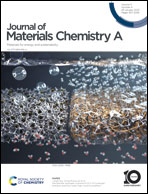A Z-scheme heterojunction of porphyrin-based core–shell Zr-MOF@Pro-COF-Br hybrid materials for efficient visible-light-driven CO2 reduction†
Abstract
Converting CO2 to high value-added products through “artificial photosynthesis” under mild conditions is a promising strategy. However, it is still a challenge to fabricate efficient photocatalysts. In this work, NH2–UiO-66 was used as the core, and Pro-COF-Br was in situ coated on the core according to the Schiff-base reaction, and hence a series of novel core–shell hybrid materials was constructed. The introduction of the core gave the hybrid materials abundant unsaturated metal sites and coating Pro-COF-Br on the core endowed them with high surface area, outstanding physicochemical stability, and high CO2 capture capacity. In addition, the porphyrin structure on the Pro-COF-Br shell greatly improved visible light utilization and the formed C![[double bond, length as m-dash]](https://www.rsc.org/images/entities/char_e001.gif) N covalent bonds at the interface increased the transfer rate of the photogenerated electrons. In particular, the formation of a Z-scheme heterostructure significantly enhanced the separation efficiency of the photogenerated electrons and holes, and thus improved the visible-light-driven CO2 reduction. The synthesized product, namely, M@C–Br-1, exhibited the highest CO yield of 106.35 μmol g−1, about 2.6 times higher than that exhibited by Zr-MOF (40.65 μmol g−1) and 3.2 times higher than that exhibited by Pro-COF-Br (33.21 μmol g−1), and the CO/CH4 selectivity was as high as 63.17%. This work offers a facile and effective strategy to construct novel core–shell MOFs@COF photocatalysts with good photocatalytic performance.
N covalent bonds at the interface increased the transfer rate of the photogenerated electrons. In particular, the formation of a Z-scheme heterostructure significantly enhanced the separation efficiency of the photogenerated electrons and holes, and thus improved the visible-light-driven CO2 reduction. The synthesized product, namely, M@C–Br-1, exhibited the highest CO yield of 106.35 μmol g−1, about 2.6 times higher than that exhibited by Zr-MOF (40.65 μmol g−1) and 3.2 times higher than that exhibited by Pro-COF-Br (33.21 μmol g−1), and the CO/CH4 selectivity was as high as 63.17%. This work offers a facile and effective strategy to construct novel core–shell MOFs@COF photocatalysts with good photocatalytic performance.



 Please wait while we load your content...
Please wait while we load your content...